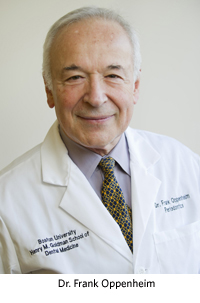Dr. Frank Oppenheim and Colleagues Publish Promising Research on Genetically Enhanced Antimicrobial Salivary Proteins
 Henry M. Goldman Distinguished Scientist and Professor of Periodontology & Oral Biology Dr. Frank Oppenheim—along with co-authors Drs. Eva J. Helmerhorst, Urs Lendenmann, and Gwynneth D. Offner—build on decades of research achievement on the structure and function of salivary proteins in the article “Anti-candidal activity of genetically engineered histatin variants with multiple functional domains,” published in the December 12, 2012, issue of the online journal PLoS One.
Henry M. Goldman Distinguished Scientist and Professor of Periodontology & Oral Biology Dr. Frank Oppenheim—along with co-authors Drs. Eva J. Helmerhorst, Urs Lendenmann, and Gwynneth D. Offner—build on decades of research achievement on the structure and function of salivary proteins in the article “Anti-candidal activity of genetically engineered histatin variants with multiple functional domains,” published in the December 12, 2012, issue of the online journal PLoS One.
This recent article describes how Dr. Oppenheim and his collaborators genetically engineered variants of a type of human salivary protein that is known to exhibit antifungal and antibacterial activities. Variants of the protein histatin 3 were produced by duplicating functional domains in its amino acid sequence.
The findings are significant in several aspects. First, the study demonstrates that duplicating active domains in histatins can enhance their antifungal properties. This suggests that these peptides can be exploited for clinical purposes. In addition, the findings may provide an evolutionary explanation for the existence of frequent domain duplication in older salivary proteins.
Leading in the early research of these histadine-rich salivary proteins, Dr. Oppenheim and his team of researchers were the first to describe the complete amino acid sequences of the proteins, to outline their ability to kill pathogens in the human oral cavity, and to call them histatins.
The hypothesis in Dr. Oppenheim’s recently published research that functional domain duplication would lead to amplification of the antifungal properties in histatins comes in part from evolutionary research. In research on proteins found in the saliva of various types of primates, Dr. Edwin A. Azen established that histatins are evolutionarily young—less than 40 million years old—as compared to older salivary proteins like mucins. The conclusion is based on the fact that histatins, while absent in the saliva of New World monkeys, are found in Old World monkeys. The evolution of the two primate groups diverged around 35 to 40 million years ago, after plate tectonics completely separated their habitats by ocean.
A prominent difference between evolutionarily older and younger salivary proteins is that the older proteins show multiple domain duplications in their amino acid sequences. Dr. Oppenheim hypothesizes that, given millions more years of evolution, histatins might duplicate their antimicrobial domains. In a sense, Dr. Oppenheim and his collaborators were able to speed up advantageous evolution by duplicating the antimicrobial domains in histatins in their lab.
“It’s a pretty exciting concept to possibly show evolutionary anticipation, but this could also be clinically exploited by making molecules which are more active,” said Dr. Oppenheim of the findings.
In fact, histatin preparations have already been shown to be effective in reducing candida infections (thrush) in AIDS patients. Dr. Oppenheim explains that clinical applications could be as simple as an antibacterial and antifungal mouthwash. Clinical applications of genetically enhanced histatins outside of dentistry, such as treatments for skin infections, are also possible.
Using a substance that the body produces naturally has many advantages over common chemical antiseptics like chlorhexidine. Synthetically-produced chemicals always carry the potential to produce allergies or sensitivities in patients, Dr. Oppenheim notes.
There are compelling reasons to move forward with research into large scale clinical production. First, there is the advantage that histatins are naturally occurring substances in the body that will be less susceptible to immune resistance. In addition, resistance to existing antifungal and antibacterial treatments is increasing. According to Dr. Oppenheim, clinical use of genetically enhanced histatins is not far off. So far, bringing down the cost of production is one of the greater obstacles.
Dr. Oppenheim’s research in oral biology continues with a quest to understand the mechanism by which histatins are able to kill microorganisms, such as the fungus Candida albicans.